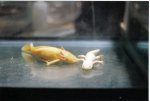Tim S
New member
Has anyone considered that some of the metomorphing Axolotls that have been reported may be mutations. Neoteny in Ambystoma mexicanum is controlled by a single recessive gene. So, a single mutation back to the ancestral gene (for metamorphosis) will cause the Axolotl to metamorphose.







